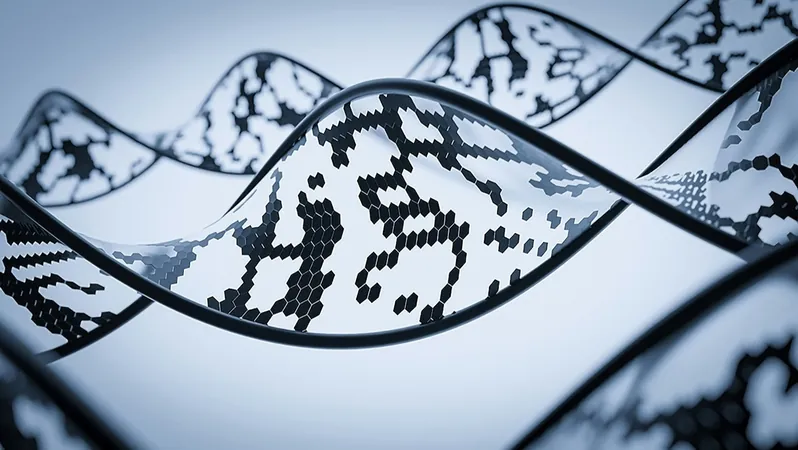
Revolutionary AI Can Now Create Entirely New Genomes from Scratch – The Future of Genetics is Here!
2024-11-18
Author: Li
Introduction
In a groundbreaking development, a new AI system named Evo has successfully designed a completely novel genome using the four foundational letters of DNA. This technology, inspired by large language models like ChatGPT, marks a significant leap in both artificial intelligence and genetic engineering.
Background of Evo
Evo was developed by a collaboration between researchers at Stanford University and the Arc Institute. Unlike traditional AI, which often learns from internet content, Evo was trained on an extensive database comprising nearly three million genomes collected from various microbes and bacteriophages—the viruses that infect bacteria. This unprecedented training allowed the AI to delve into billions of lines of genetic code.
Performance of Evo
Remarkably, Evo surpassed previous AI models in predicting how mutations in genetic material can modify its function. Furthering its creativity, the AI generated multiple novel components for the CRISPR gene-editing technology, and even produced a genome over a megabase in length—equivalent to that of some bacterial genomes.
Evo as a Revolutionary Genomic Foundation Model
As noted by Christina Theodoris from the Gladstone Institute, who was not directly involved with the project, Evo serves as a revolutionary genomic foundation model. This means it can aid scientists in investigating evolutionary patterns, understanding cellular functions, solving biological puzzles, and accelerating the progress of synthetic biology by designing intricate new biomolecules.
Understanding the Language of Life
DNA comprises only four letters—adenine (A), thymine (T), cytosine (C), and guanine (G)—and its complexity often puzzles researchers. While human language is structured with defined words and sentences, DNA does not possess such punctuation, making its interpretation more challenging. Each letter in DNA carries multiple layers of information, sometimes allowing a single strand to code for different proteins based on various cellular contexts.
Evo's Design and Functionality
Recognizing the intricate nature of DNA, Evo was specifically designed to analyze genetic data at the level of individual DNA letters, overcoming issues that typically hamper AI's ability to process such continuous and complex information.
Architecture of Evo
Evo’s architecture incorporates a unique AI framework known as StripedHyena, which enhances its ability to tackle large inputs efficiently. The training involved a diverse array of genetic materials, including plasmids that facilitate the transfer of genetic information between bacteria and play a role in the development of antibiotic resistance.
Evo vs Other AI Models
With its advanced training, Evo was pitted against other AI models to evaluate the impacts of genetic mutations. It emerged victorious, even outperforming models explicitly trained to identify relevant protein-coding sequences—showing signs of a “fundamental understanding of DNA grammar,” according to Theodoris.
CRISPR Editing Tool Creation
Evo’s capabilities were put to the test when tasked with creating new versions of the CRISPR editing tool. The AI successfully produced millions of potential Cas proteins paired with guide RNA molecules, from which researchers synthesized and experimentally verified the efficacy of selected combinations. Among these, a novel Cas9 variant stood out, precisely cleaving its DNA target, exemplifying the promising potential of AI-assisted gene editing.
Limitations of Evo
While Evo demonstrated the ability to design a new DNA sequence of significant length, researchers found that the resulting genome showed essential genes for survival but lacked certain crucial characteristics for functionality. This points to the fact that while Evo can generate impressive genomic designs, it still has limitations, sometimes producing sequences—termed “hallucinations” in AI lingo—that wouldn’t work in practice.
Future Perspectives
Despite the current constraints, Evo's achievements hint at a future where AI could revolutionize genetics research. If advancements allow Evo to decode or construct larger genomes typical of plants, animals, and humans, the implications could be groundbreaking. This may not only reshape diagnostics and therapeutic strategies for diseases but could also inspire innovative applications in bioengineering, such as creating eco-friendly biofuels or medications.
Conclusion
As we stand on the brink of this new frontier in genetic science, one thing is clear: Evo is paving the way for an exciting era in biotechnology and artificial intelligence. The race is on to unlock the full potential of AI in the field of genomics!




 Brasil (PT)
Brasil (PT)
 Canada (EN)
Canada (EN)
 Chile (ES)
Chile (ES)
 España (ES)
España (ES)
 France (FR)
France (FR)
 Hong Kong (EN)
Hong Kong (EN)
 Italia (IT)
Italia (IT)
 日本 (JA)
日本 (JA)
 Magyarország (HU)
Magyarország (HU)
 Norge (NO)
Norge (NO)
 Polska (PL)
Polska (PL)
 Schweiz (DE)
Schweiz (DE)
 Singapore (EN)
Singapore (EN)
 Sverige (SV)
Sverige (SV)
 Suomi (FI)
Suomi (FI)
 Türkiye (TR)
Türkiye (TR)